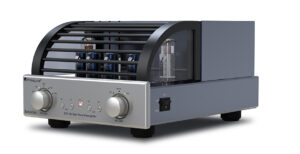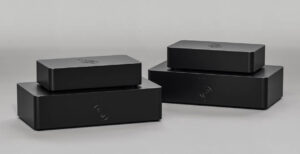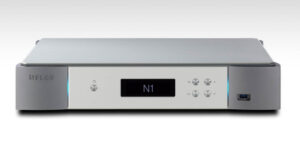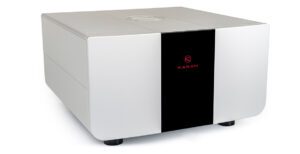
Trilogy Audio Systems is a small British amplifier manufacturer, best known for making hybrid amplifiers that rely on valves for their performance and not their looks. This is because seemingly unlike many manufacturers, Trilogy’s Nic Poulson actually read the EU regulations on electrical safety and isn’t too keen on breaking those rules by leaving exposed something that can at once cut, burn, and electrocute. This is what separates the simply ‘small’ from the ‘small, but highly professional’, and the 925 drips professionalism.
The 925 is Trilogy’s first integrated amplifier, and could be considered a hybrid within a hybrid: not only does it combine hollow and solid-state technologies (two Russian 6N6π triode valves per channel supply pure Class A voltage gain for the 925’s input stage, in an otherwise all-silicon design), it uses an intriguing zero feedback bridge configuration that combines the electrical and sonic benefits of both MOSFET and bipolar devices, all providing a meaty-sounding 125W per channel and a solid, but not immobile, case.
The circuit itself is very short, very symmetrical, and very ‘belt and braces’ in design. Switching is by ruthenium relays, because they sound good and are built to last. The valves are servo controlled to make them extremely symmetrical (and Trilogy’s own discreet HT shunt regulation provides them with optimum voltage feed with no potential for ‘sagging’). And that volume control is actually a digitally controlled potentiometer, allowing for 1dB steps in volume and balance. And, of course, key power supply feeds are kept entirely separate, which is why when you pop the cover on the 925, you are met with a huge toroidal transformer.

The hybrid output stage is worth examining. MOSFETs are wonderfully linear output devices (it’s why they are so often the solid-state choice for valve amp manufacturers turning to transistors), but their high-current performance is not so hot. Bipolar transistors are great at providing high-current muscle, but seldom sound as refined as FETs. There have been many ways to try to overcome this fundamental dichotomy in output stage performance (usually involving a lot of hand-selection, or buying up vast quantities of a typically discontinued ‘wonder’ transistor, both of which significantly increase the per-unit cost of the amplifier). Trilogy’s solution is to build a bridge: two power amplifiers per channel that simultaneously push and pull power to the loudspeaker. This allows the FET to do its ‘first watt’ thing without the heavy lifting of the bipolars to mess up the system ground with large amount of current, even when heavy lifting is required. The amp runs in Class AB, but also runs high bias, which is like saying more Class A than B. This is very carefully monitored by the amp’s own logic system, but does mean the heatsinks get warm to the touch.
Trilogy is keen to stress the 925 is part of an amplifier system, and uses the company’s own RJ45-based TAS link to connect the amplifier to other Trilogy products and the outside world. This allows user configurability of a Trilogy based system down to a very refined degree; power-on volume and balance can be preset, that LED matrix can be set to any level (or to track ambient light levels), and you can even set a seven-day timer to warm up the amplifier remotely while you are still commuting (even to the point of knowing you work late on Thursdays, so power up a couple of hours later that day), rather like what Hive or Nest does with heating systems.
Naturally, with that large red dot matrix panel, products can be assigned names and given trimmed gain levels, but the TAS link also provides status monitoring of connected devices. The two RJ45 connectors are divided into a high-speed data line to communicate between control circuits for general ‘housekeeping’ tasks, and a low-data rate QuietBus that monitors the audio circuitry spends most of its time in active, and therefore keeps digital control noise out of the signal chain. There’s even a PIN code to lock the amp.

These functions are best controlled from a remote handset, and not necessarily the little plastic one that comes as standard, but the matching aftermarket PRC or Personal Remote Control. You can also control these functions through the front panel, using the ‘ENT’, ‘ESC’ and volume dial to navigate the menus, but only if you like watching movies about safecracking.
The amplifier very definitely needs a short warm up before it comes on song every time it is powered up. There is a ‘hand on the heatsinks’ test that you should apply before listening; when the heatsinks are cold, the 925 sounds flat, mechanical, and distant. When they aren’t, the amp comes to life, and when they are the just the right side of uncomfortably warm (after about half an hour) the sound is transformed.
This is a balanced amplifier; the sonic differences between balanced and single-ended are relatively mild, so while you won’t lose out by using RCAs, if you can go balanced, you should. In fact, ‘balanced’ is also the best description of the Trilogy 925’s performance, whatever input you use. Although this may be Trilogy’s first integrated amp, the 925 is a mature design from a mature designer for a mature audience (‘mature’ in the ‘refined and sophisticated’ sense, not that it only appeals to an older generation).
This is not an amp that does ‘chocolatey mids’, ‘velvet highs’, ‘powerful bass’, or any other aspect of the adjective soup we audiophiles use to describe sound, unless that aspect of the presentation is called for by the recording or the source component itself. The key indicator to this is not picking out individual recordings but when changing from one recording to another; the changes in soundstage width and depth, the changes in dynamics from album to album, the subtlety of recording engineering, the way the microphones were used, the mix, and the master are all easy to hear. This chameleon-like property means the amp imposes no significant character on the sound. This may not be the most dynamic sounding praise for an amplifier, but in fact it’s this quality that marks the 925 out as one of the finest integrated amplifiers you can buy today.
Move from small scale (‘Lucky’ by Kat Edmonson’s Way Down Low album on MRI) to the largest (the final movement of Mahler’s Ninth Symphony, conducted by Solti on Decca) and the 925 behaves like a different amplifier, moving from something like a single-ended triode when playing breathy girl-with-guitar to a beefy powerhouse when Mahler throws everything at the listener. The same happens with tonal range, the light and fluffy ‘Lucky’ doesn’t have the same bolted down underpinnings of the Ninth. These are extremes, but the same ‘no amp’ performance applies universally. It’s only on really bilargeg scale music played loud on big, difficult to drive loudspeakers that the Trilogy 925 show its hand – and its limits. Otherwise, it’s a sophisticated, transparent amplifier that is actually really rather rare in our world.

Let’s dispel the big myth. The Trilogy 925 doesn’t use valves to make the amp sound ‘valvey’ or ‘soft’ or ‘warm’. It uses valves because they are the right device for the task at hand. Their linearity in the preamp means a more natural, less overtly forward sounding signal is fed to the power amplifier stage. The use of MOSFETs and bipolars combined helps to deliver the same more natural, less overtly forward sounding signal to the loudspeakers. This means what the 925 sounds like is a damn good amplifier: the kind that doesn’t draw attention to itself, and that’s the kind you end up keeping for years and years. Very highly recommended.
Technical Specifications
- Type: hybrid integrated line amplifier:
- Inputs: 3× XLR stereo pair (balanced), 3× RCA stereo pair and 1× 3.5mm front-mounted stereo jack (single‑ended)
- Outputs: 1× RCA stereo pair (single-ended tape send), multi-way loudspeaker terminals:
- Comms: 2× RJ45 TAS link connectors
- Rated power: 135W per channel (eight ohms)
- Frequency Response: 10Hz–50kHz ± 0.5dB
- Distortion: Less than 1% A weighted at rated output
- Finish: soft natural silver/aluminium as standard; Mediterraneo Blue and Nero Carbonio paint finish, or ‘Chameleon Colour System’ options
- Dimensions (W×H×D): 44.5×43×12.7cm
- Weight: 25.5kg
- Price: £8,995
Manufactured by: Trilogy Audio Systems
URL: www.trilogyaudio.com
Tel: +44(0)20 8856 0616
Distributed in the UK by: Symmetry
URL: www.symmetry-systems.co.uk
Tel: +44(0)1727 865488
Tags: FEATURED
By Alan Sircom
More articles from this authorRead Next From Review
See all
PrimaLuna EVO 100 phono preamplifier
- Apr 22, 2024

Reiki Audio SuperSwitch Master Pro + Servant Pro
- Mar 27, 2024

Melco Audio N1-S38 music server
- Mar 27, 2024











